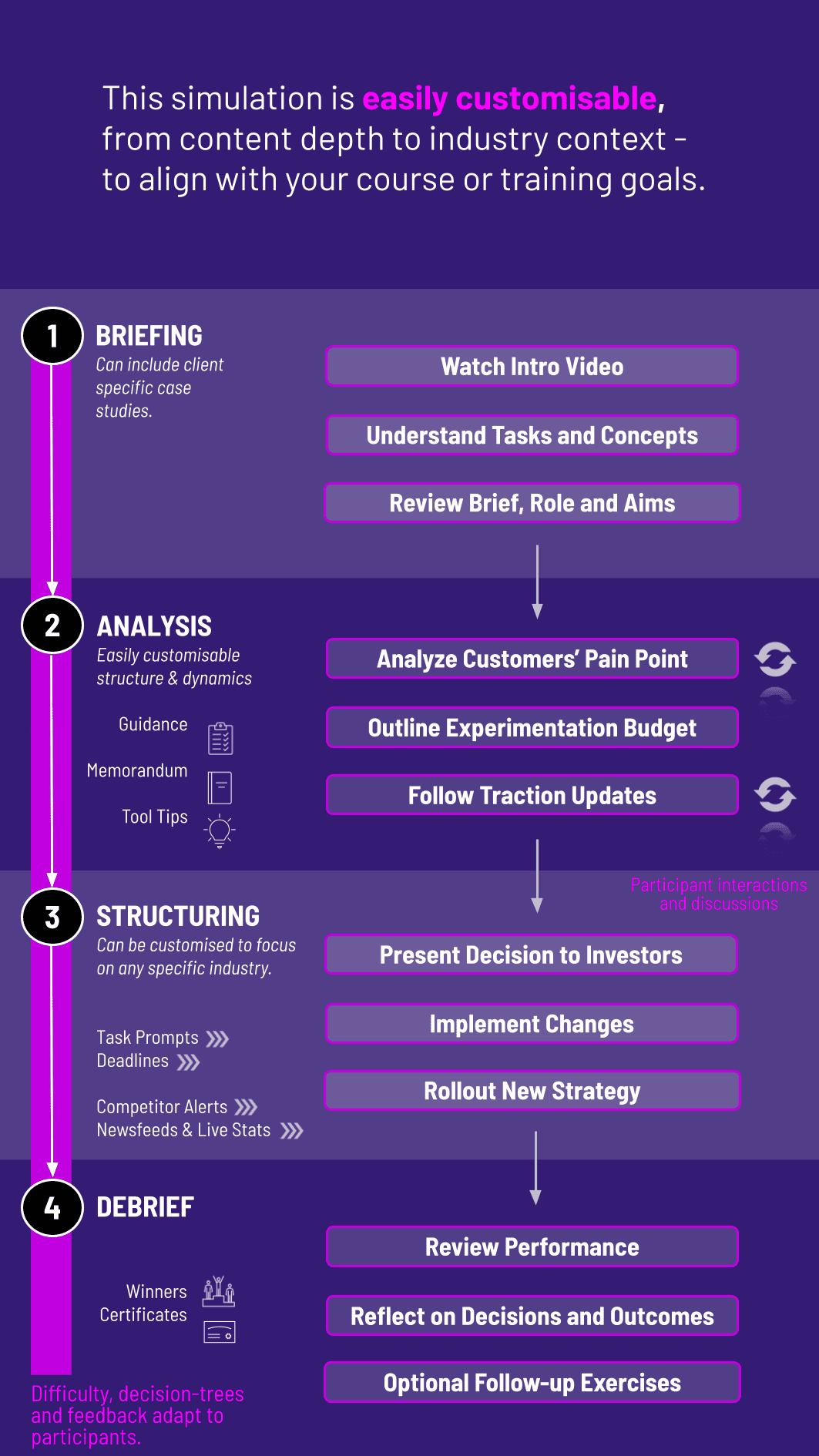
In this hands-on Product-Market Fit Simulation, participants act as startup founders navigating customer discovery, product iteration, and go-to-market pivots to achieve traction, growth, and investor confidence under uncertain conditions.
Problem validation and customer discovery
MVP design and iteration
Market segmentation and targeting
Feature prioritization and user feedback
Traction metrics and growth loops
Lean experimentation and pivot logic
Storytelling and investor alignment
Team dynamics and co-founder conflict
Burn rate management and early revenue
Product vs. sales-led growth decisions


Conduct mock customer interviews and synthesize findings
Design and iterate on MVPs
Choose which markets or segments to target
Allocate budget to experiments, marketing, or development
Track traction metrics and adjust their approach
Communicate pivots and progress to internal teams or investors
By the end of the simulation, participants will be able to:
Understand the principles behind product-market fit
Conduct structured customer discovery
Design MVPs with clear hypotheses
Interpret feedback and market signals with clarity
Make tough prioritization calls with limited data
Practice lean experimentation and agile iteration
Develop investor narratives grounded in evidence
Align product features to real customer pain points
Assess growth metrics and pivot intelligently
Work collaboratively under uncertainty and time pressure
The simulation’s flexible structure ensures that these objectives can be calibrated to match the depth, duration, and focus areas of each program, whether in higher education or corporate learning.
The simulation is perfect for academic entrepreneurship courses, startup bootcamps, and corporate innovation labs. Each round simulates a product-building sprint or market feedback cycle.
1. Receive a Brief: Participants receive a startup scenario and set of initial assumptions. The brief may include target customers, team roles, constraints, and product goals.
2. Explore and Validate: Participants explore customer needs through mock interviews, test landing pages, or concept feedback. They assess what problems are worth solving.
3. Make Product and Strategy Decisions: Based on input, teams design MVPs, run experiments, set pricing, or pivot entirely. They allocate budget across learning, marketing, and product efforts.
4. Respond to Market Signals: Traction updates, investor pressure, or team disagreements force new decisions. Participants must interpret weak signals and recalibrate.
5. Communicate and Reflect: Teams document their decisions through pitch decks, memos, or investor updates. They also reflect on what changed and why.
6. Repeat the Cycle: Each new round builds on the last - just like a real startup sprint. The iteration loop deepens with each cycle.
Do participants need startup experience? Not at all. The simulation is designed to be accessible to beginners while still challenging for more experienced learners.
What types of startups are included? You can choose from B2B SaaS, D2C brands, consumer apps, or fintechs. Industry context can be tailored.
Can this be run in teams? Yes. It works especially well in teams where participants can take on roles like CEO, Product Lead, or Marketing Head.
Is this based on real-world frameworks? Yes. The simulation draws from lean startup, customer development, and venture capital evaluation principles.
Is there an investor or pitch component? Yes, optionally. Final rounds can include pitching to instructors, peers, or real investors.
What kind of data is included? Participants see metrics like CAC, churn, activation rates, engagement, NPS, and qualitative customer quotes.
How long is the simulation? It can run in as little as 90 minutes or be embedded into multi-day intensives. You control the pacing and complexity.
Can it simulate a pivot? Absolutely. Teams are encouraged to change course based on evidence and outcomes.
Is it useful for corporate innovation teams? Yes. Intrapreneurship teams will benefit from the same principles around testing assumptions and customer-centricity.
Depth of customer discovery and insight synthesis
Evidence-based MVP and product decisions
Strategic alignment of pivots or iterations
Communication of learnings and investor storytelling
Agility in adapting to new information
Collaboration across product, marketing, and team roles
You can also include memo writing and debrief presentations as part of the assessment structure. Additionally, you can also add a built-in peer and self-assessment tool to see how participants rate themselves. This flexibility allows the simulation to be easily integrated by professors as graded courses at universities and by HR at assessment centres at companies.
Join this 20-minute webinar, followed by a Q&A session, to immerse yourself in the simulation.
or
Book a 15-minute Zoom demo with one of our experts to explore how the simulation can benefit you.